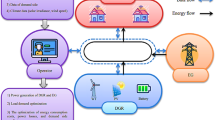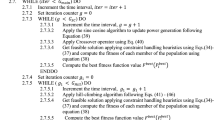Abstract
In a power system, the incurred transmission loss and the associated sensitivity factors are dependent on the selection of the slack bus and the dispatch. In this paper, a fast two-stage, hydro-thermal generation scheduling process, which is also inclusive of the system power loss, is proposed. A novel approach towards estimating power loss sensitivity factors is presented which is independent of the choice/location of the slack bus in the network. In addition to this, the approach identifies the loss incurred by the operation of different market players including the generation and distribution companies for penalizing. Mixed integer linear programming is used to model the said optimal day-ahead scheduling problem. The two-stage process employed is such that the first stage is applied only in the planning stage, while second is a fast responsive algorithm suitable for very short-term applications. A real network, Vietnam Power Grid, is used for testing this proposed approach, and the results obtained demonstrated that there is significant reduction in the electricity cost and total transmission loss.















Similar content being viewed by others
Abbreviations
- Symbol:
-
Explanation
- T :
-
Generation scheduling period
- K :
-
Number of power plant
- \(C_T\) :
-
Total amount paid by electricity buyers
- \(Pr_k\) :
-
Contractual electricity price of power plant k
- \(Q_k (t)\) :
-
Contractual energy generated at hour t by power plant k
- Pm(t):
-
Electric price at hour t
- \(Qm_k (t)\) :
-
Actual energy generated at hour t by power plant k
- \(Csd_k (t)\) :
-
Shutdown cost of power plant k
- \(Cst_k (t)\) :
-
Start-up cost of power plant k
- GD(t):
-
Gross demand of system at hour t
- ND(t):
-
Net demand at hour t
- Loss(t):
-
Transmission loss at hour k
- \(Qmax_k\) :
-
Maximum power of power plant k
- \(Qmin_k\) :
-
Minimum power of power plant k
- \(u_k (t)\) :
-
Status of power plant k at hour t, 1 if power plant is synchronized, 0 if vice versa
- UR(t):
-
Power requirement for ramping up at hour t
- DR(t):
-
Power requirement for ramping down at hour k
- \(Emax_k\) :
-
Maximum energy available for hydro-power plant k at scheduling period because of long-term optimization
- \(Ethmax_k\) :
-
Upper energy limit of thermal power plant k
- \(Ethmin_k\) :
-
Lower energy limit of thermal power plant k
- \(RU_k\) :
-
Ramping up per hour limit of thermal power plant k
- \(RD_k\) :
-
Ramping down per hour limit of thermal power plant k
- \(on_k (t)\) :
-
Variable presents state of power plant k at hour t, equal to 1 if start-up, 0 if not
- \(off_k (t)\) :
-
Variable presents state of power plant k at hour t, equal to 1 if shutdown, 0 if not
- \(Ton_k \) :
-
Minimum time thermal power plant k must synchronized before changing state
- \(Toff_k\) :
-
Minimum time thermal power plant k must unsynchronized before changing state
- \(\varDelta t\) :
-
Time for water flow from hydro-power plant k to h
- \(WQ_k (t)\) :
-
Minimum energy requirement of hydro-power plant k at hour t, represented water discharge required by local government
- \(Emax_{Ng} (t)\) :
-
Maximum total power at hour t of group of thermal power plant which is supplied by common gas system
- \(T'_k\) :
-
Period power plant k must be synchronized due to grid security constraint
- \(lmin_{ij}\) :
-
Minimum transfer capability from area i to area j
- \(lmax_{ij}\) :
-
Maximum transfer capability from area i to area j
- \(GD_i (t)\) :
-
Gross demand of area i at hour t
- \(Q_{(k,i)} (t)\) :
-
Output of generation k in area i at hour t
- \( \varDelta Loss\) :
-
Transmission loss change due to generation change
- \( \varDelta Q_i\) :
-
Generation change of power plant i
References
Albadi MH, El-Rayani YM, El-Saadany EF, Al-Riyami HA (2018) Impact of solar power projects on LMP and transmission losses in Oman. Sust Energy Technol Assess 27:141–149
Bharti D, De M (2016) A new graph theory based loss allocation framework for bilateral power market using diakoptics. Int J Elect Power Energy Syst 77:395–403
Bhuiya A, Chowdhury N (1999) “Allocation of transmission losses in a deregulated power system network,” in Electrical and Computer Engineering, 1999 IEEE Canadian Conference on, pp. 1148–1152 vol.2
Bialek J (1997) Topological generation and load distribution factors for supplement charge allocation in transmission open access. Power Syst IEEE Transac on 12:1185–1193
Cheung JNY, Czaszejko T, Morton AB (2007) Transmission loss evaluation in an open electricity market using an incremental method. IET Gen Trans Distrib 1(1):189
Conejo JMAAJ, Alguacil N, Guijarro AL (2002) Transmission loss allocation: a comparison of different practical algorithms. IEEE Trans Power Syst 17(3):571–576
Conejo AJ, Arroyo JM, Alguacil N, Guijarro AL (2002) Transmission loss allocation: a comparison of different practical algorithms. Power Syst IEEE Transact on 17:571–576
Early ED, Smith GL (1955) A general transmission loss equation, transactions of the american institute of electrical engineers. Part III Power Apparat Syst 74(3):510–520
Galiana FD, Conejo AJ, Kockar I (2002) Incremental transmission loss allocation under pool dispatch. IEEE Trans Power Syst 17(1):26–33
German Morales-Espana JML, Ramos Andres (2013) Tight and compact milp formulation of start-up and shut-down ramping in unit commitment. IEEE Trans Power Syst 28(2):1288–1296
Huang GM, Zhang H (1999) Transmission loss allocations and pricing via bilateral energy transactions, in Power Engineering Society Summer Meeting, 1999. IEEE 2:720–725
Imran Ahmad Quadri, Bhowmick S, Joshi D (2018) “A comprehensive technique for optimal allocation of distributed energy resources in radial distribution systems”. Appl Energy, 211
Keshmiri SN, Ehsan M (2008) “Transmission loss allocation using normalized loss weight factors,” in 2008 Third International Conference on Electric Utility Deregulation and Restructuring and Power Technologies, Nanjing, China, pp. 431–435
Leautier T-O (Oct. 2000) Regulation of an electric power transmission company. The Energy J, 21(4)
Mohsen Nemati, Martin Braun, Stefan Tenbohlen (2018) Optimization of unit commitment and economic dispatch in microgrids based on genetic algorithm and mixed integer linear programming. Appl Energy 210:944–963
Motalleb Mahdi, Ghorbani Reza (2017) Non-cooperative game-theoretic model of demand response aggregator competition for selling stored energy in storage devices. Appl Energy 202
Mustafa MW, Sulaiman MH, Shareef H, Khalid SNA, Rahim SRA, Alima O, “An application of Genetic Algorithm and Least Squares Support Vector Machine for tracing the transmission loss in deregulated power system,” (2011) 5th International Power Engineering and Optimization Conference. Shah Alam, Selangor 2011:375–380
Nimal Madhu M, Sasidharan N, Singh JG (2016) A droop control incorporated dc equivalent power flow method for distribution and low voltage systems. Electr Power Syst Res 134:56–65
Ramos JLM, Exposito AG, Moron F (2003) Becerra S (2003) On the use of loss penalty factors for generation scheduling, in Power Engineering Society General Meeting, 2003. IEEE 2:926–931
Satyaramesh P, RadhaKrishna C (2010) Usage-based transmission loss allocation under open access in deregulated power systems. IET gener, Trans distrib 4(11):1261–1274
Shih-Chieh Hsieh, Hsin-Min Wang (2002) “Allocation of transmission losses based on cooperative game theory and current injection models,” IEEE International Conference on Industrial Technology, IEEE ICIT ’02., pp. 850–853, Bangkok, Thailand
Sulaiman MH, Mustafa MW, Aliman O (2008) Power flow and loss tracing in deregulated transmission system using proportional tree method. Int Rev Elect Eng (IREE) 3:691–698
Teng J-H (2005) “Power flow and loss allocation for deregulated transmission systems”, International J Elect Power Energy Syst, pp.327–334
Young-Hyun M, Byoung-Kon C, Heon-Su R, Jae-Suk J, Ho-Min P (2000) “Slack-bus independent penalty factor for spot pricing under deregulation,” in 2000 IEEE Power Engineering Society Winter Meeting. Conference Proceedings (Cat. No.00CH37077), vol. 2, pp. 1017–1021
Zarabadipour H, Mahmoudi A (2017) A novel loss allocation in pool markets using weight-based sharing and voltage sensitivity analysis. Electr Power Syst Res 152:84–91
Acknowledgements
Authors would like to acknowledge the financial and technical support provided by NLDC Vietnam and Asian Institute of Technology, Thailand.
Author information
Authors and Affiliations
Corresponding author
Additional information
Publisher's Note
Springer Nature remains neutral with regard to jurisdictional claims in published maps and institutional affiliations.
Rights and permissions
About this article
Cite this article
Phuoc, N.H., Ongsakul, W., Manjiparambil, N.M. et al. A slack-bus-independent loss sensitivity approach for optimal day-ahead generation scheduling. Electr Eng 104, 421–434 (2022). https://doi.org/10.1007/s00202-021-01297-3
Received:
Accepted:
Published:
Issue Date:
DOI: https://doi.org/10.1007/s00202-021-01297-3




